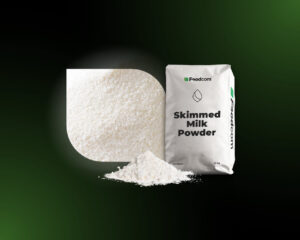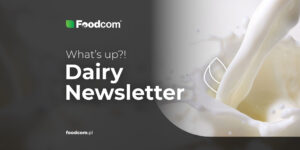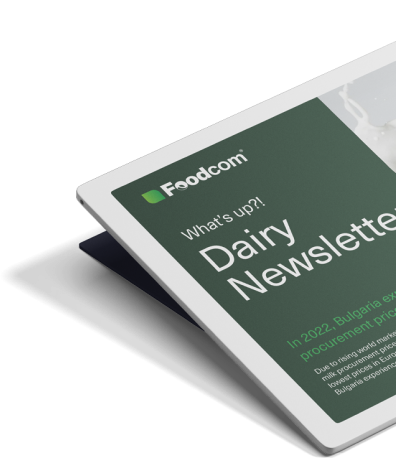- Milk powder prices in Europe continue to fall, with producers struggling with high costs and competition from Oceania.
- The cheese market is seeing declines in Gouda, Edam, Cheddar and Mozzarella, while Emmental remains more stable.
- Butter and cream are under strong pressure, with liquid components and skimmed milk concentrates adjusting downwards.
- The whey and whey protein segment remains balanced, but there are no clear signs of growth.
Welcome Partners!
Welcome back to our newsletter!
The downward trend in the European dairy market continues, with powders, cheeses and butter losing value and the cream and whey market further weakened by oversupply. In our latest report you will find current price levels and key market signals, as well as news from abroad – from the feed shortage in the UK, to the climate transformation of the dairy sector in Australia and New Zealand, to the support programme for cattle producers in the USA.
Scroll down for detailed market data and forecasts.
Milk powder
On the European market, skimmed milk powder (SMP) prices have fallen to 2200-2300 EUR/MT in both the food and feed segments. Spot sales are limited, and supply remains high while exports are weak. Additional pressure came from the recent decline in GDT auction prices, which prompted some sellers to lower their offers.
In the United States, SMP prices remain around 2275-2330 EUR/MT. Production is not at record levels, but high milk procurement and limited domestic demand mean that the market remains dependent on exports, mainly to Mexico. However, buyers are still taking advantage of the US price advantage over Europe.
In Oceania, SMP is trading at 2220-2300 EUR/MT, and producers are preparing for the upcoming milk season, which promises to be very strong. The prospect of high volumes in the coming months is causing additional caution on the part of buyers.
The full cream milk powder (FCMP) market in Europe remains stable at 3850-4000 EUR/MT, but sales are mainly based on contracts, with little spot activity. Oceania is recording lower levels of around 3220 EUR/MT as a result of strong competition and abundant supply, further reinforced by the fall in prices at recent GDT auctions.
Cheese
The European cheese market is undergoing a marked correction. Prices for Gouda and Edam have fallen in recent weeks to 3600–3700 EUR/MT, the lowest level in many months. Surplus production in Europe, combined with limited exports, is putting pressure on sales. Many factories that had hoped to maintain higher prices are now forced to accept much weaker offers to avoid further accumulation of stocks.
Mozzarella is trading at 3450–3550 EUR/MT. Traditionally, the summer period supports this segment thanks to catering demand, especially in Southern Europe. This time, however, the seasonal effect was not enough to offset the large supply – prices are falling steadily and producers are trying to shift volumes to contract customers, minimising the share of spot sales.
Cheddar in Europe is currently trading at 4100-4200 EUR/MT and is also under external pressure. Imports from Oceania and the United States are affecting European prices – American Cheddar in particular, which is priced below 3400 EUR/MT, remains attractive to many third markets. Oceania is maintaining prices closer to 3850-4050 EUR/MT, but is benefiting from well-established sales channels in Asia.
Emmental is showing slightly more resilience, trading in the range of 4350-4500 EUR/MT, but here too, supply pressure is limiting the potential for growth. Sales are mainly concentrated in contracts for the processing industry, with spot offers appearing less frequently and usually at lower levels.
Overall, the European cheese market is entering a challenging period for producers – high raw material availability and growing competition from cheaper imports mean that there is currently no room for prices to rebound.
Fats
The European butter market remains under significant pressure. Quotations have fallen to 6300–6500 EUR/MT, with some spot offers even lower. Surpluses of high-fat milk, growing inventories and limited export opportunities mean that producers are increasingly forced to compete aggressively on price. In recent weeks, the return of some processors to butter production from surplus cream has also contributed to the decline, further increasing the availability of the product on the market.
Non-European markets are also recording lower levels, but the spreads are wide. Oceania is maintaining prices around 5900-6000 EUR/MT, benefiting from demand in Asia, while in the United States butter has fallen to just ~3800 EUR/MT, which clearly reduces the competitiveness of EU exports.
The AMF segment in Europe is currently trading in the range of 7200-7400 EUR/MT. Demand remains stable, particularly from industry and exports, keeping prices within a relatively narrow range. Compared to the sharp declines in the butter market, the anhydrous fat market remains more balanced.
Liquids
The cream market in Europe has weakened sharply in recent weeks. Cream prices have fallen to 7200-7400 EUR/MT, whereas not long ago they were still above 8000 EUR/MT. Such a strong correction is mainly due to the high availability of milk and the high supply of fat in the raw material. Some processors have decided to redirect surplus cream to butter production, which has increased sales pressure on the spot market.
There are noticeable differences in regional trade – in Western Europe, cream is still selling at slightly higher prices, while in Germany and Central Europe, prices have fallen more rapidly and buyers are forcing price adjustments.
The market for skimmed milk concentrate (SMC) remains more stable. Prices for the German product are in the range of 2000-2050 EUR/MT, and supply is limited due to growing interest in protein in processing. Despite price stability, margins for producers remain tight, especially when revenues from powders and cheeses do not fully cover the costs of raw material production.
Whey powder
The European whey market has returned to a clearly differentiated picture between segments. Food-grade sweet whey powder (SWP) is currently trading at around 1030 EUR/MT, while feed-grade whey is trading at 920–940 EUR/MT. Production in Europe remains high thanks to the high activity of cheese factories, which ensures the supply of raw materials. In recent weeks, increased purchases by the feed industry have supported the feed segment, while food prices remain stable with moderate demand.
WPC 80 remains the strongest, with prices reaching 12 200 EUR/MT. Demand for high-protein products remains strong, and trade is mainly concentrated around regular customers, which limits availability for new customers. Prices are also rising in the US, and the difference with Europe has narrowed significantly, making it difficult to move goods between regions.
WPI remains at very high levels, around 19 500 EUR/MT in Europe. Demand is stable, but many buyers are signalling caution – prices close to 20 000 EUR/MT are limiting transaction volumes. In the United States, prices are lower, but growing cheese production is quickly absorbing supply there, which is also driving up prices.
The situation on the permeate market is much weaker. In Europe, prices have fallen to 780 EUR/MT, while in the US they remain much lower – below 500 EUR/MT. This clearly limits export opportunities from Europe, causing stocks to build up and further pressure for price reductions.
Lactose is traded in Europe at 1180 EUR/MT, although the spread between offers is very wide, ranging from around 1050 to 1500 EUR/MT. Some producers have already sold most of their volumes for this year, while others are actively seeking buyers by offering lower prices. Prices on the American market are significantly lower, which makes the product more attractive to importers in Asia.
What’s new?
Ireland
As a result of drought and earlier consumption of stocks, British farmers are facing a serious shortage of roughage for the winter season. The National Farmers’ Union has confirmed that silage stocks are already running low. Ireland, thanks to favorable weather conditions and high yields, has a surplus of feed. Irish producers are ready to respond to increased demand from the UK. This highlights the importance of strategic planning in the international dairy industry.
New Zealand
New data from Australia shows that the dairy sector must urgently adapt to increasingly frequent droughts, heatwaves, and heavy rainfall. Experts warn that the future of the dairy industry will depend on the implementation of strategic planning, active climate action, and technological innovation. Research projects such as Ag2050 point the way forward, emphasizing the need to invest in production systems that can withstand climate pressures.
United States
The United States Department of Agriculture (USDA) has announced a $1 billion support package for cattle producers affected by floods and fires in 2023–2024. The funds will be directed to farms under the Emergency Livestock Relief Program, which provides for reimbursement of up to 60% of the cost of three months’ worth of cattle feed. The program aims to stabilize the food supply chain and sustain the operations of farms most affected by extreme weather events. Applications will be accepted until October 31st , 2025.
![Milk market under pressure – price falls in Europe and global challenges [281st Edition of DAIRY Newsletter] Milk market under pressure – price falls in Europe and global challenges [281st Edition of DAIRY Newsletter]](https://foodcom.pl/wp-content/uploads/2023/08/Foodcom_SA_Whats_up_Dairy_Newsletter-1520x760.jpg)






